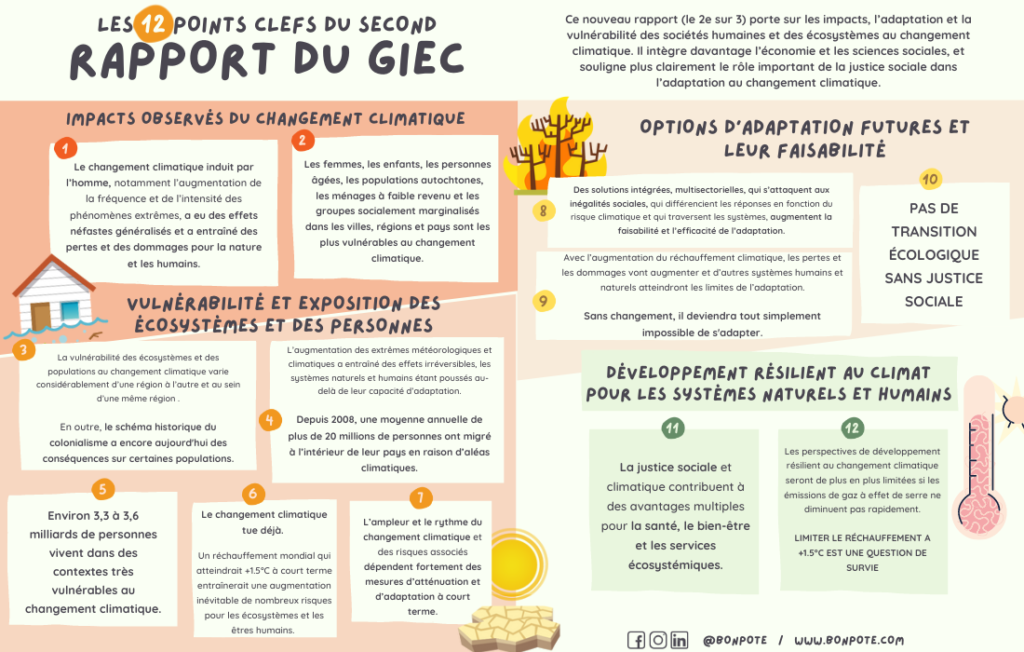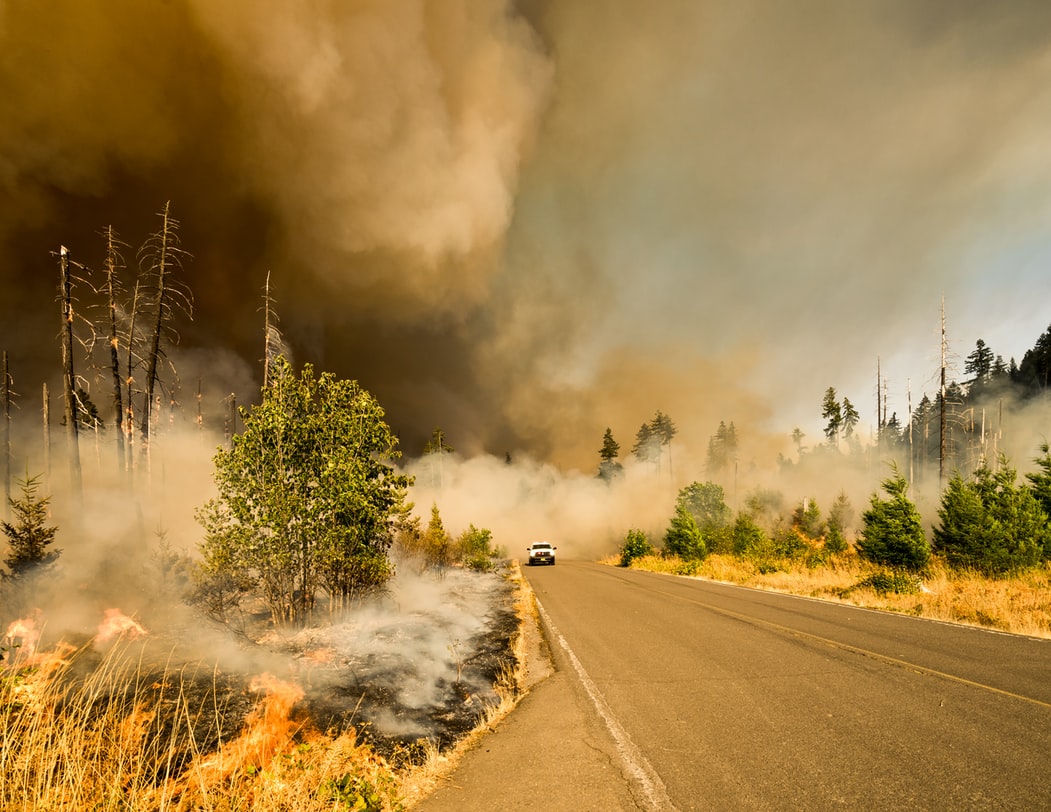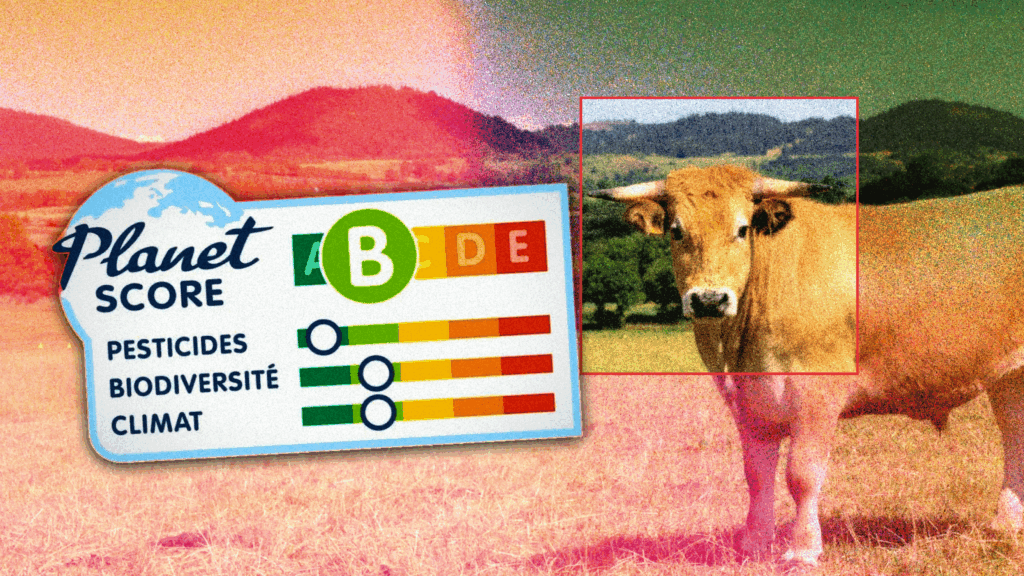After the IPCC Working Group I (WGI) report in August 2021, the second report is finally out!
While the first report focused on the physical understanding of the climate system and climate change, this last report (2nd and 3rd) pinpoints the impacts, adaptation, and vulnerability of human societies and ecosystems to climate change. Compared to previous versions, this report integrates economics and social sciences and more clearly emphasizes the importance of social justice in climate change adaptation.
The present article focuses on the Summary for Policymakers (SPM) and the Technical Summary (TS). Words used in this report are strong, concepts are essential, all validated by governments (SPM). This report insists on social and political structures, which shows, once again, that our climate future lies in our hand. Many action levers are presented in this report and such knowledge must be shared to as many people as possible.
Preface
Before you read more, it is essential to be aware of what IPCC is, how authors are selected to write the report, how scientific papers are selected, who finances it, etc. If you know it already, good for you; otherwise, read this summary. I deeply encourage you to read the first report’s summary, to help you understand better the second one.
What to remember from this second report:
- The 2nd report is a summary of 34,000 scientific papers. It was written by 269 Lead Authors who responded to 62,418 comments from governments and experts (!!!!). The Summary for Policymakers was validated, sentence by sentence, by governments after two weeks of deliberation.
- 3 versions are available:
- the Summary for Policymakers (SPM, 36 pages)
- the Technical Summary (TS, 96 pages)
- the Full Report (FR, 3,675 pages).
Tip: read the summary, several times, if necessary, as well as the technical summary, if possible. The full report should be used as an encyclopedia > to go into a thematic in-depth. Naturally, feel free to read it entirely…
- The IPCC provides calibrated language to estimate the likelihood of a single event or an outcome (indicated in italic in the reports, as described in AR5):
- Virtually certain (99-100% probability)
- Very likely (90-100% probability)
- Likely (66-100% probability)
- About as likely as not (33 to 66% probability)
- Unlikely (0-33% probability)
- Very unlikely (0-10% probability)
- Exceptionally unlikely (0-1% probability)

It is important to realize the sacrifices involved in writing an IPCC report. Scientists work voluntarily, very often in their private time, and spend sleepless nights to produce a report of the highest possible quality and accessible to everyone, particularly through the SPM and technical summary.
The last two weeks of plenary meetings were long and intense. Because of the war, Ukrainian scientists taking part in the approval session of the SPM were forced to withdraw from the meeting. These are the exceptional circumstances in which the report was finalized. Once again, thank you all. Our respect is huge.
Key points of the new IPCC report
Before diving into some of the points, here are the main findings of the new IPCC report (SPM + TS).
Observed and Projected Impacts and Risks from Climate Change
Observed Impacts from Climate Change
- B.1: Human-induced climate change, including more frequent and intense extreme events, has caused widespread adverse impacts and related losses and damages to nature and people, beyond natural climate variability. Some development and adaptation efforts have reduced vulnerability.
- Across sectors and regions, the most vulnerable people and systems are observed to be disproportionately affected. The rise in weather and climate extremes has led to some irreversible impacts as natural and human systems are pushed beyond their ability to adapt (high confidence).
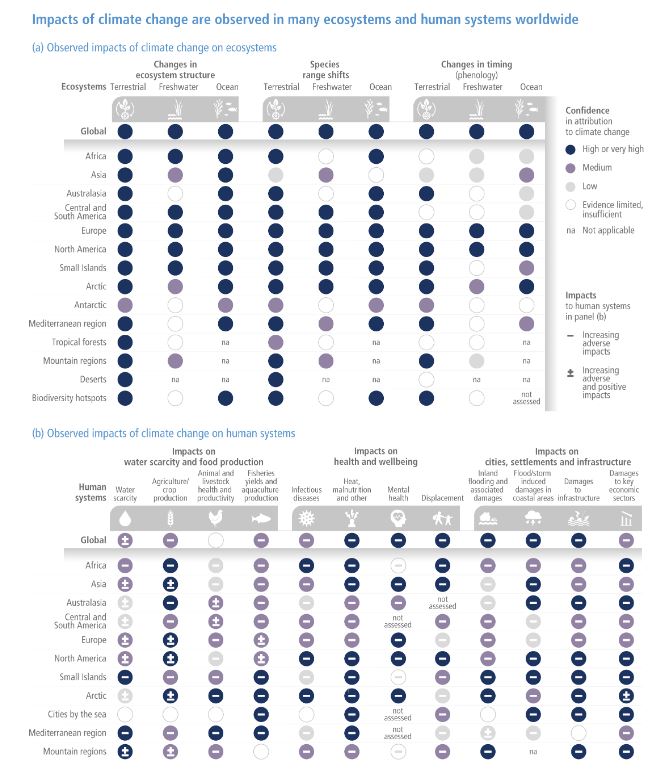
Vulnerability and Exposure of Ecosystems and People
- B.2: Vulnerability of ecosystems and people to climate change differs substantially among and within regions (very high confidence), driven by patterns of intersecting socioeconomic development, unsustainable ocean and land use, inequity, marginalization, historical and ongoing patterns of inequity such as colonialism, and governance (high confidence).
- Approximately 3.3 to 3.6 billion people live in contexts that are highly vulnerable to climate change (high confidence).
- A high proportion of species is vulnerable to climate change (high confidence). Human and ecosystem vulnerability are interdependent (high confidence). Current unsustainable development patterns are increasing the exposure of ecosystems and people to climate hazards (high confidence).
Risks in the Near-term (2021-2024)
- B.3: Global warming, reaching 1.5°C in the near-term, would cause unavoidable increases in multiple climate hazards and present multiple risks to ecosystems and humans (very high confidence). Near-term actions that limit global warming to close to 1.5°C would substantially reduce projected losses and damages related to climate change in human systems and ecosystems, compared to higher warming levels, but cannot eliminate them all (very high confidence).
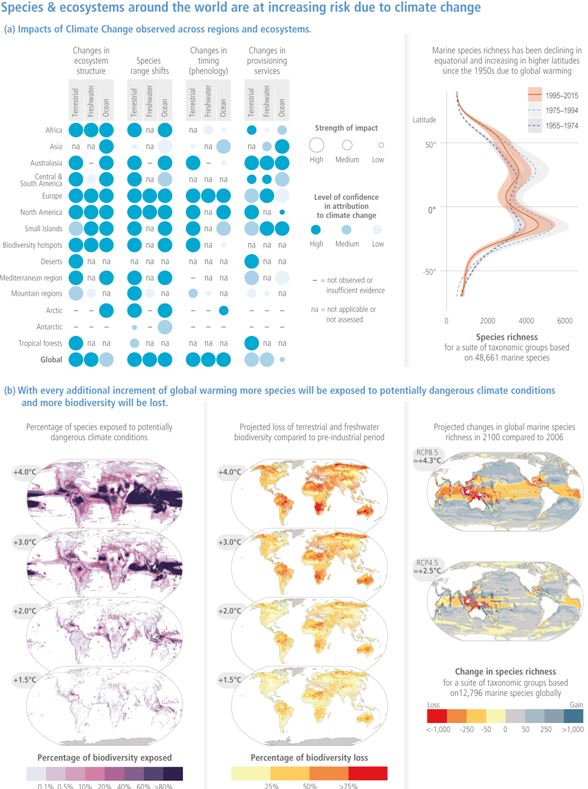
Mid to Long-term Risks (2041-2100)
- B.4: Beyond 2040 and depending on the level of global warming, climate change will lead to numerous risks to natural and human systems (high confidence). For 127 identified key risks, assessed mid- and long-term impacts are up to multiple times higher than currently observed (high confidence).
- The magnitude and rate of climate change and associated risks depend strongly on near-term mitigation and adaptation actions and projected adverse impacts and related losses and damages escalate with every increment of global warming (very high confidence).
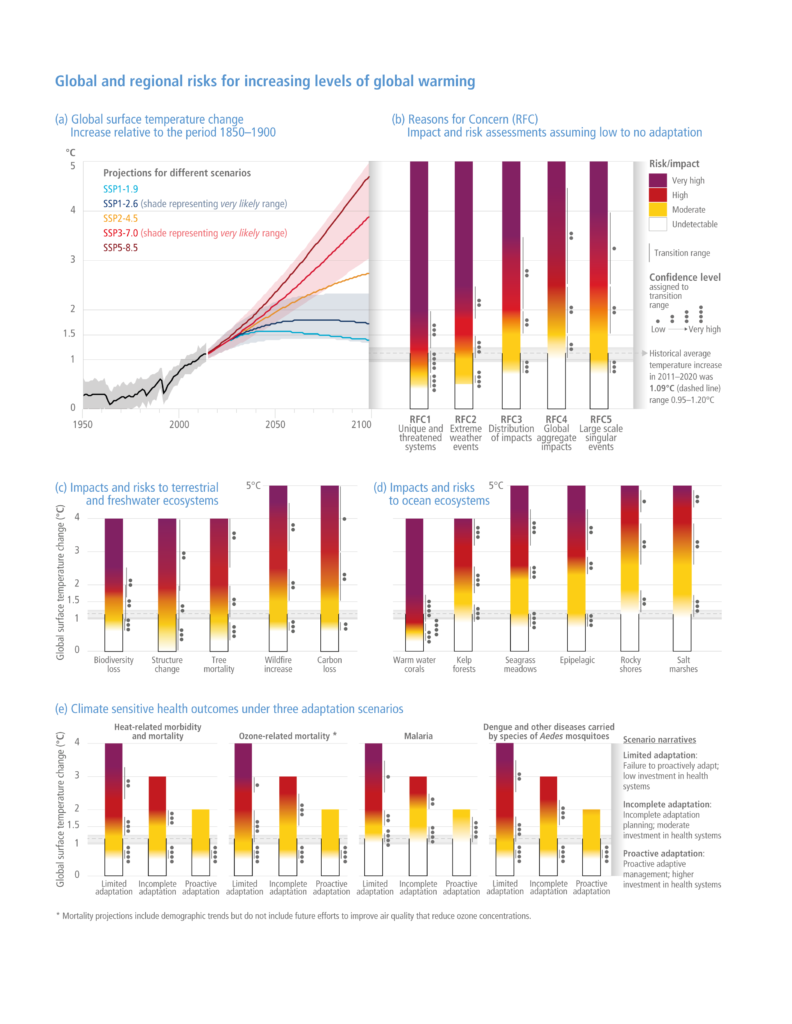
Complex, Compound and Cascading Risks
- B.5: Climate change impacts and risks are becoming increasingly complex and more difficult to manage. Multiple climate hazards will occur simultaneously, and multiple climatic and on-climatic risks will interact, resulting in compounding overall risk and across sectors and regions. Understand “Risk cascading” as multiple simultaneous risks (e.g., heatwave, followed by a wildfire that occurred in Canada in June 2021).
- B.6: If global warming transiently exceeds 1.5°C in the coming decades or later (overshoot), then many human and natural systems will face additional severe risks, compared to remaining below 1.5°C (high confidence). Depending on the magnitude and duration of overshoot, some impacts will be irreversible, even if global warming is reduced (high confidence).
Adaptation Measures and Enabling Conditions
Current Adaptation and its Benefits
- C.1: Progress in adaptation planning and implementation has been observed across all sectors and regions, generating multiple benefits (very high confidence). However, adaptation progress is unevenly distributed with observed adaptation gaps (high confidence).
- Many initiatives prioritize immediate and near-term climate risk reduction, which reduces the opportunity for transformational adaptation (high confidence).
Future Adaptation Options and their Feasibility
- C.2: There are feasible and effective adaptation options that can reduce risks to people and nature. The feasibility of implementing adaptation options in the near-term differs across sectors and regions (very high confidence). Integrated, multi-sectoral solutions that address social inequities, differentiate responses based on climate risk and cut across systems, increase the feasibility and effectiveness of adaptation in multiple sectors (high confidence).
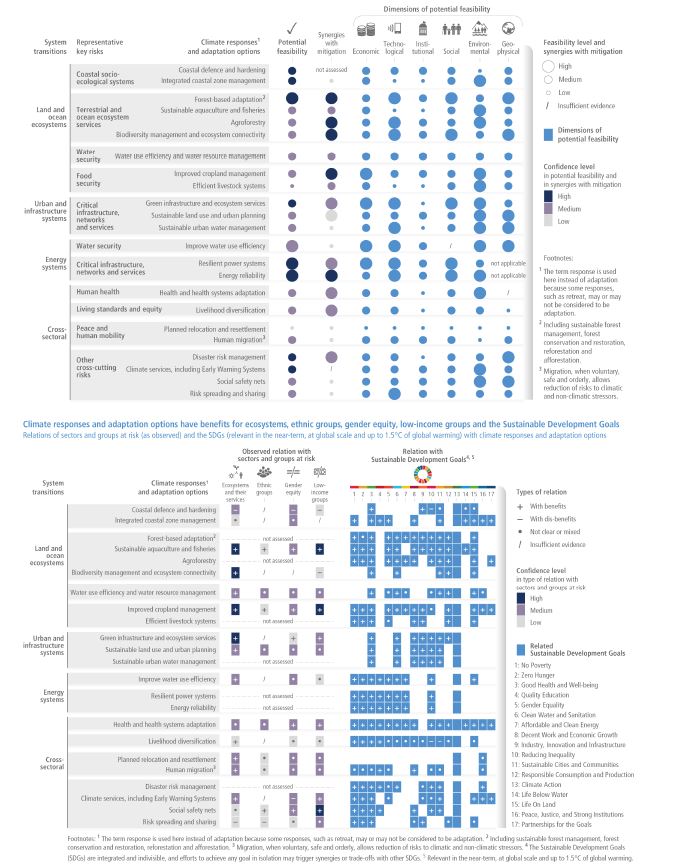
Figure SPM.4 from IPCC Sixth Assessment Report, WG2
Limits to Adaptation
- C.3: Soft limits to some human adaptation have been reached, but can be overcome by addressing a range of constraints, primarily financial, governance, institutional, and policy constraints (high confidence).
- Hard limits to adaptation have been reached in some ecosystems (high confidence). With increasing global warming, losses and damages will increase and additional human and natural systems will reach adaptation limits (high confidence).
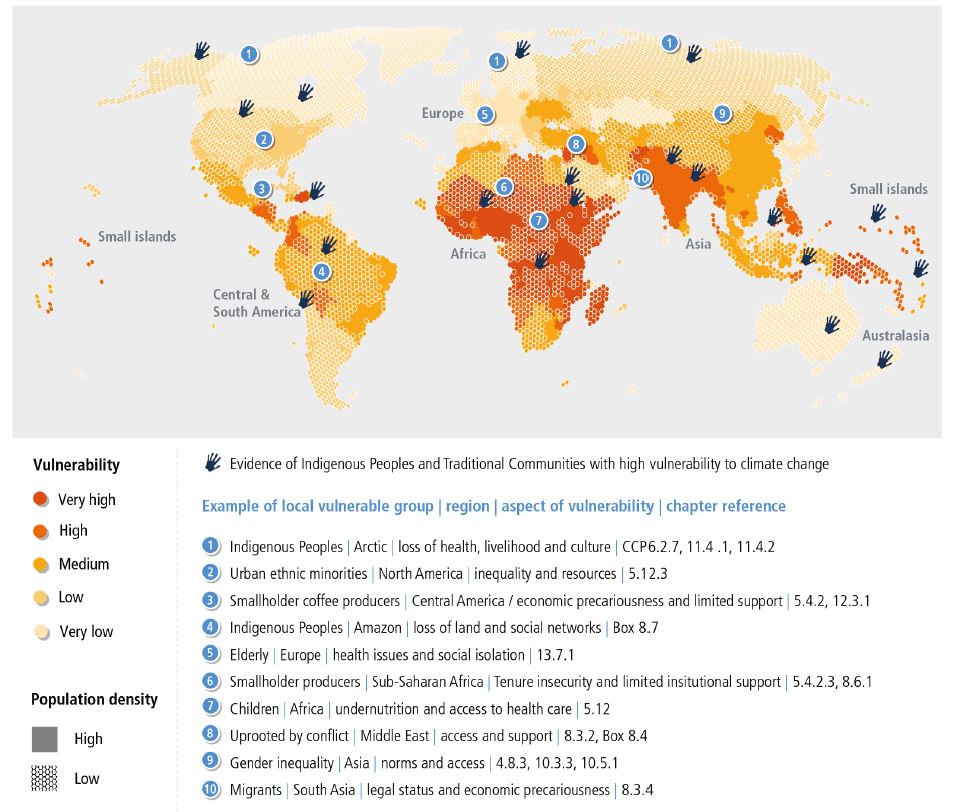
Figure TS.7 from IPCC Sixth Assessment Report, WG2
Avoiding Maladaptation
- C.4: Maladaptive responses to climate change can create lock-ins of vulnerability, exposure and risks that are difficult and expensive to change and exacerbate existing inequalities.
- Maladaptation can be avoided by flexible, multi-sectoral, inclusive and long-term planning and implementation of adaptation actions with benefits to many sectors and systems. (high confidence)
Climate Resilient Development
Conditions for Climate Resilient Development
- D.1: Evidence of observed impacts, projected risks, levels and trends in vulnerability, and adaptation limits, demonstrate that worldwide climate-resilient development action is more urgent than previously assessed in IPCC AR5. Comprehensive, effective, and innovative responses can harness synergies and reduce trade-offs between adaptation and mitigation to advance sustainable development.
- D.2: Climate resilient development is enabled when governments, civil society and the private sector make inclusive development choices that prioritise risk reduction, equity and justice, and when decision-making processes, finance and actions are integrated across governance levels, sectors and timeframes (very high confidence).
- Climate resilient development is facilitated by international cooperation and by governments at all levels working with communities, civil society, educational bodies, scientific and other institutions, media, investors and businesses, and by developing partnerships with traditionally marginalised groups, including women, youth, Indigenous Peoples, local communities and ethnic minorities (high confidence).
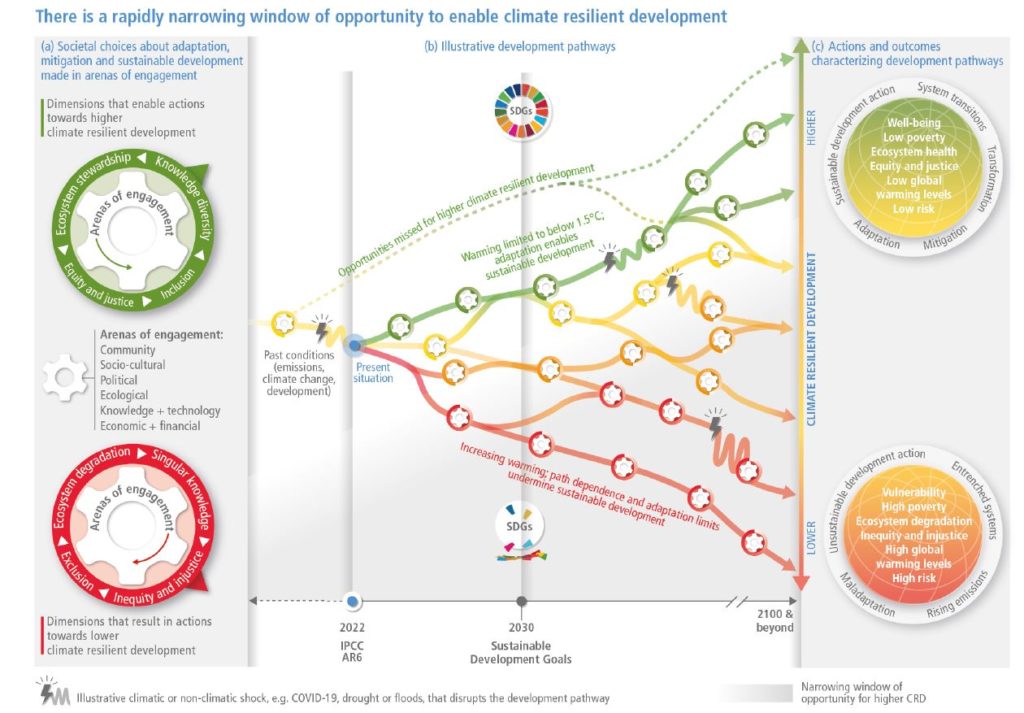
This figure builds on Figure SPM.9 in AR5 WGII (depicting climate resilient pathways) by describing how CRD pathways are the result of cumulative societal choices and actions within multiple arenas.
Figure SPM.5 from IPCC Sixth Assessment Report, WG2
Climate Resilient Development for Natural and Human Systems
- D.3: Interactions between changing urban form, exposure and vulnerability can create climate change-induced risks and losses for cities and settlements. However, the global trend of urbanisation also offers a critical opportunity in the near-term, to advance climate resilient development (high confidence).
- Integrated, inclusive planning and investment in everyday decision-making about urban infrastructure, including social, ecological and grey/physical infrastructures, can significantly increase the adaptive capacity of urban and rural settlements.
- Equitable outcomes contribute to multiple benefits for health and well-being and ecosystem services, including for Indigenous Peoples, marginalised and vulnerable communities (high confidence).
- D.4: Safeguarding biodiversity and ecosystems is fundamental to climate resilient development, in light of the threats climate change poses to them and their roles in adaptation and mitigation (very high confidence). Maintaining the resilience of biodiversity and ecosystem services at a global scale depends on effective and equitable conservation of approximately 30% to 50% of Earth’s land, freshwater and ocean areas, including currently near-natural ecosystems (high confidence).
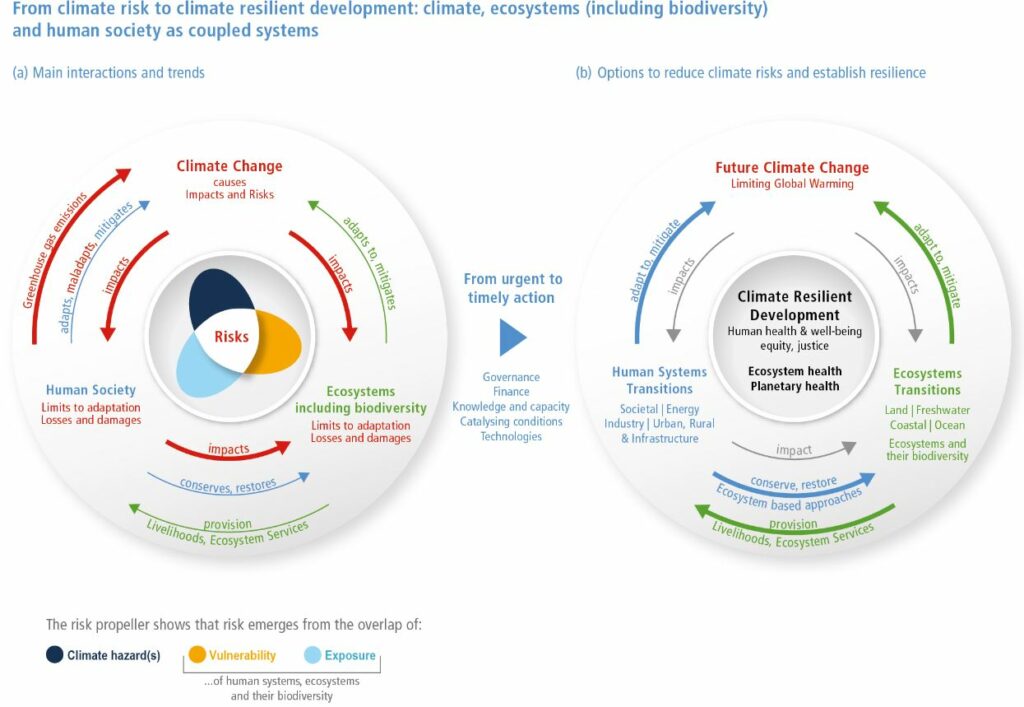
Achieving Climate Resilient Development
- D.5: Societal choices and actions implemented in the next decade determine the extent to which medium and long-term pathways will deliver higher or lower climate resilient development (high confidence).
- Importantly climate resilient development prospects are increasingly limited if current greenhouse gas emissions do not rapidly decline, especially if 1.5°C global warming is exceeded in the near-term (high confidence).
NEWSLETTER
Chaque vendredi, recevez un condensé de la semaine, des infographies, nos recos culturelles et des exclusivités.
ALERTE
Une alerte dans votre boite mail, pour être mis au courant dès qu’un nouvel article est en ligne sur Bon Pote
Detailed Analysis of the New Report Key Points
Digesting such a scientific report takes time. The complex effects of climate change on our societies become very clear once one delves into the TS, or the full report itself. Although it remains difficult to make a selection, hereafter are some elements that caught my attention.
Climate Change is already killing, and has been for several years
The rise of heatwaves, droughts, and floods already exceed the plants and animals’ tolerance threshold, resulting in massive deaths of tree and coral species. These extreme weather events occur simultaneously, leading to cascading repercussions that are increasingly difficult to manage.
Such events expose millions of people to acute food and water insecurity, especially in Africa, Asia, Central and South America, small islands and the Arctic. To prevent more loss of human lives, biodiversity and infrastructures, it is urgent and vital to implement ambitious and accelerated adaptation measures to climate change.
Will France be spared?
When skimming the different maps of the report, some might assume that France will be rather spared compared to other countries. It is indeed likely that France will suffer less than Madagascar or Cambodia. Nevertheless, French people will not be spared from climate change! And we are not ready for it. Or at least, very poorly..
France will, as well, be exposed to droughts, floods, heatwaves, wildfires… and some regions more severely than others, such as French Overseas Departments and Territories (DOM-TOM) and the Mediterranean basin (one chapter is dedicated to it). In this regard, Virginie Duvat (Lead Author of AR6) identifies the DOM-TOM as frontline territories that will be firstly and particularly affected by climate change
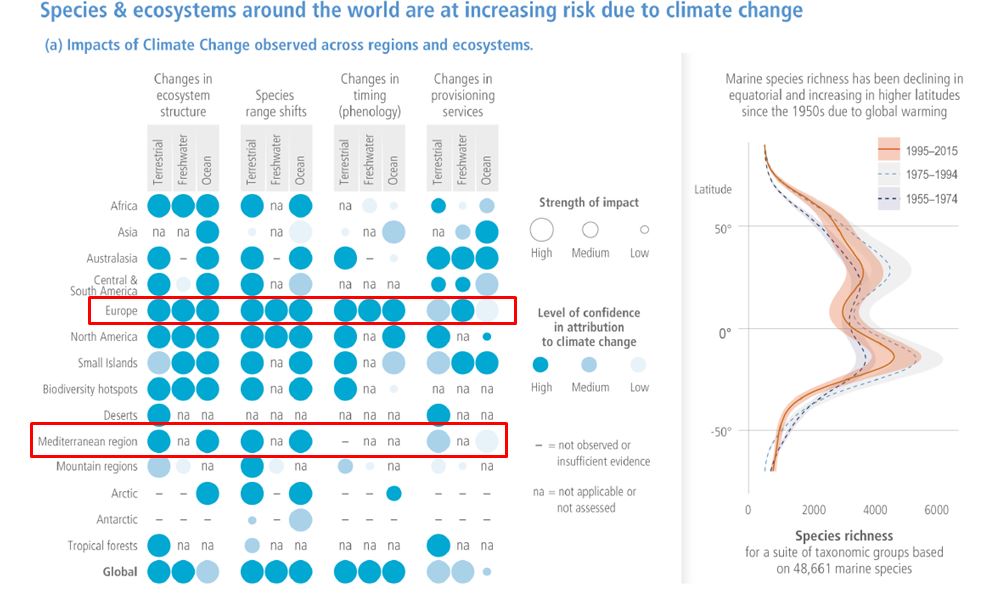
Losses and Damages
Losses and Damages are considered the 3rd important component of climate change, right after mitigation and adaptation. This is a critical point raised by numerous countries that are already suffering from climate change, and which require compensation for climate hazards that are impossible to adapt to.
There is ample evidence of Losses and Damages in the AR6 report. Let’s hope this will give more weight to the negotiations at the next COP27 and will offset the pathetic behavior of Northern countries at COP26. The budget requested is completely justified and is in line with climate justice: the highest emitting countries must pay for the damage they cause and will cause.
Colonialism and Climate Justice
You may feel like you misread, but you did not: the IPCC mentioned colonialism as a sign of unsustainability! Although this is evident, why is this so important that it is stated in an IPCC report? Simply because this Summary for Policymakers gathers a whole body of scientific literature, sometimes defamed, which has been verified by the governments.
B.2: Vulnerability of ecosystems and people to climate change differs substantially among and within regions (very high confidence), driven by patterns of intersecting socioeconomic development, unsustainable ocean and land use, inequity, marginalization, historical and ongoing patterns of inequity such as colonialism, and governance (high confidence).
The roots of such vulnerability are partly related to the present as well as inherited political, economic, and social contexts. Equity presumes taking into account both current and historical inequalities. In particular, considering the colonial period is essential to understand the unequal adaptation capacities of certain States, and more specifically of certain populations or territories within these States.
It is important to remember that most of the available data is at the national level. Therefore, they do not recognise the strong inequalities that exist within continents, States, regions, or cities. In other words: Souths exist, including within Norths, no matter what territory one lives in. It has been proven that the more individuals or social groups suffer from exclusion, discrimination, and deprivation of access to economic, social, and cultural resources, the less they are able to adapt.
Fairness and climate justice require not only the distribution of the costs and benefits but also the compensation, one way or another, of the initial inequalities.
Mental and Physical Health
Special attention is paid in this report to mental health, yet completely left aside by public authorities… when not mocked by some who consider ecologists melodramatic. And still… Hereafter are two paragraphs from the TS – that we will come back to in other articles – devoted to mental health.
TS. B.5: Climate change has already harmed human physical and mental health (very high confidence). In all regions, health impacts often undermine efforts for inclusive development. Women, children, the elderly, Indigenous People, low-income households, and socially marginalized groups within cities, settlements, regions, and countries are the most vulnerable (high confidence).
TS. B.5.2: Mental health challenges increase with warming temperatures (high confidence), trauma associated with extreme weather (very high confidence), and loss of livelihoods and culture (high confidence).
Migration and Climate Change
TS.B.6: Since the last IPCC report, there is increasing evidence that climate hazards associated with extreme events and variability act as direct drivers of involuntary migration and displacement, and as indirect drivers through deteriorating climate-sensitive livelihoods (high confidence).
As a reminder, most climate-related displacement and migration occur within national boundaries, while international movements primarily occur between countries with contiguous borders. Since 2008, an annual average of 20 million people have been internally displaced annually by weather-related extreme events. The most common climatic drivers for migration are droughts, tropical storms and hurricanes, heavy rains and floods (high confidence).
Finally, the impacts of climatic drivers on migration are highly context-specific and interact with social, political, geopolitical, and economic drivers (high confidence).
Finally Shining the Light on African Continent
IPCC really focused on regional impacts of climate change. As we know, global warming of +2°C will not equally affect all regions of the world.
Africa is one of the continents that has contributed the least to greenhouse gases emissions, still several regions have already been severely affected by the effects of climate change. In addition, the continent is one of the most exposed to climate change:
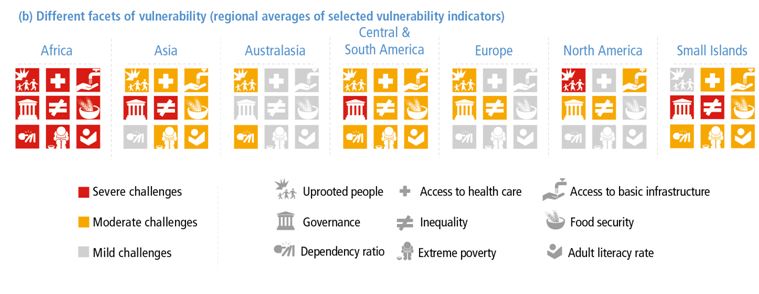
This exposure is combined with a very high vulnerability, closely related to extreme poverty and multiple inequalities in access to health, education, food security, and political instability. However, the continental scale does not reflect the very high inequalities within the same continent.
Please note: Figure TS.7 (above) shows that Africa is the most vulnerable continent overall. This does not mean that the other continents are spared! The report shows that all continents will indeed be affected and are far behind in their adaptation policies.
Limiting Climate Change to +1.5°C is no longer an Option
Limiting global warming to +1.5°C should significantly reduce the Losses and Damages caused to the economy, agriculture, health, and environment. Above +2°C, the adaptation costs will become prohibitive and unaffordable for millions of people.
Biodiversity is also omnipresent in this report. Global warming levels above +2°C will result in a rapid increase in the risks of ecosystem extinction and collapse(confiance élevée). Working Group 1 was already very clear in August 2021 (and has been for years): every emitted tonne of CO2 adds to climate change. If we want to avoid recurring tipping points and maintain a liveable planet for the majority of its inhabitants, mitigation and adaptation are no longer options.

Let’s not forget: if we fail to keep global warming to +1.5°C, the next target is not +2°C, but +1.51°C.
The last word
This new IPCC WP2 report brings many confirmations, bad news… but also encouraging ones. No, “not everything is over, we all are not going to die“. We do have our climate future in our hands, it is up to us to drastically, quickly, and sustainably reduce our emissions.
Once again, it is the first time in history that a scientific report has, and will have so much importance, for the scientific, political, geopolitical, and economical communities. Its findings will be decisive for the upcoming negotiations at COP27, amongst others.
I reiterate: everyone should at least read the Summary for Policymakers. Everyone should get familiar with it and then look deeper into the different subjects. Its conclusions are crystal clear, and accessible for everyone to understand. The last point of the SPM perfectly summarizes the richness of the report and leaves no more doubt on the crucial role of politics in the combat against climate change.
The cumulative scientific evidence is unequivocal: Climate change is a threat to human well-being and planetary health. Any further delay in concerted anticipatory global action on adaptation and mitigation will miss a brief and rapidly closing window of opportunity to secure a liveable and sustainable future for all.
BONUS: a 12-point infographic summarising the report (download in HD for printing here)
BONUS: keep abreast of media coverage of the IPCC report (it is… not great)
BONUS 3: the third and last IPCC report just went out!
